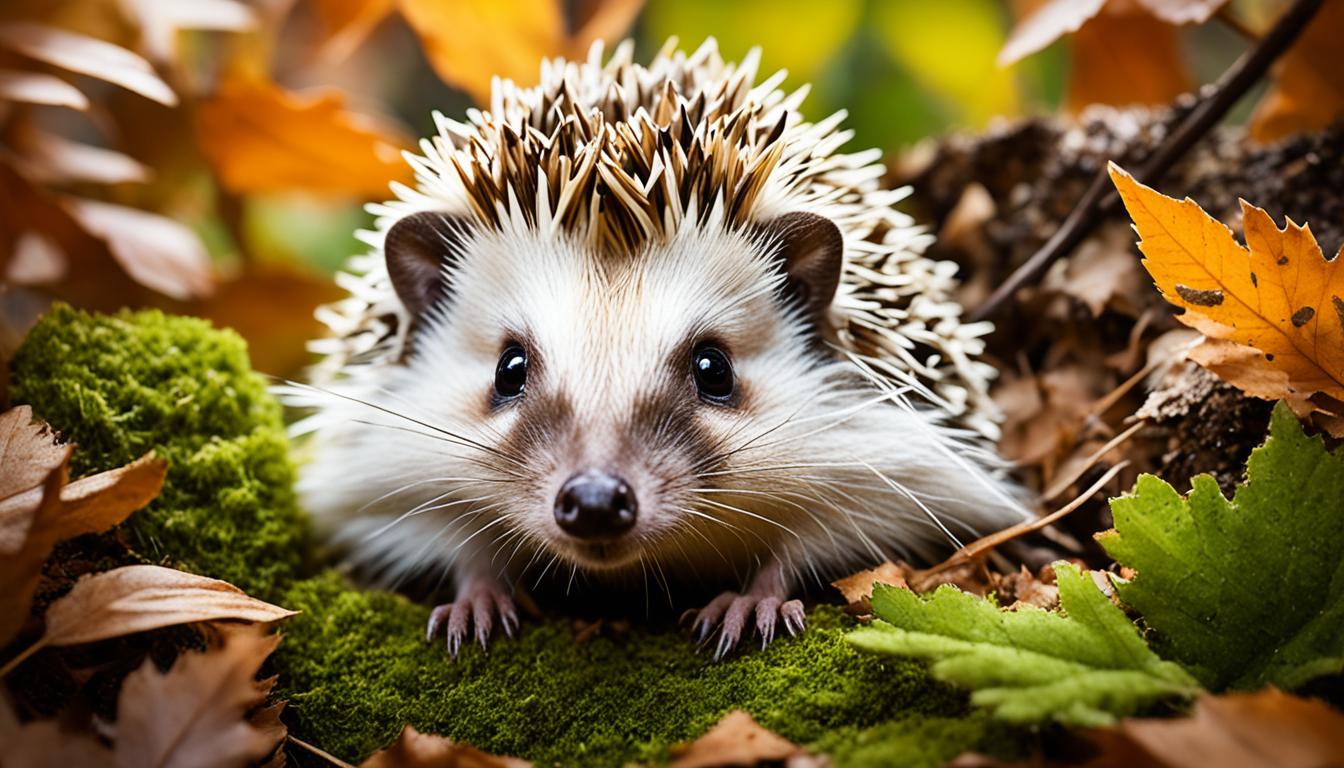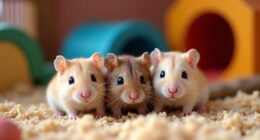Did you realize that hedgehogs have unique personalities and quirky behaviors that make them captivating pets? These prickly animals have a wide range of characteristics that add to their individuality and charm. By comprehending their special traits, you can form a stronger connection with your hedgehog and give them the proper care they require.
Key Takeaways:
- Hedgehogs have distinct personalities and quirky behaviors.
- Understanding your hedgehog’s traits helps you build a stronger bond.
- Hedgehogs communicate through body language and vocalizations.
- They have specific housing and environmental needs.
- Hedgehogs are naturally nocturnal and have unique sleep patterns.
Body Language and Quills
When it comes to understanding hedgehogs, their body language and unique quills play a significant role. Hedgehogs are covered in quills, which are modified hairs that serve as a form of protection. These quills not only provide a spiky defense mechanism but also communicate important information about their emotions and mood.
One of the most common behaviors you’ll notice in hedgehogs is their tendency to curl into a tight ball. This behavior helps protect their vulnerable underbelly and exposes their quills as a warning signal. When a hedgehog curls into a ball, it is a clear indication that they feel threatened, scared, or defensive.

The position and direction of their quills can also provide insight into their emotional state. When a hedgehog is calm and content, its quills typically lie flat against its body. Conversely, if a hedgehog is feeling anxious, agitated, or stressed, its quills may stand on end, creating a spiky appearance.
Understanding their body language, including quill behavior, can help you determine how to interact with your hedgehog appropriately. For instance, if your hedgehog is curled into a ball or its quills are raised, it’s best to give them space and avoid any sudden movements or loud noises that might further stress them.
Observing their body language and responding accordingly is crucial for building trust and fostering a positive relationship with your hedgehog.
Hedgehog Body Language and Quill Behavior
| Quill Position | Emotional State |
|---|---|
| Quills flat against body | Calm and content |
| Quills raised and pointed | Anxious, agitated, or stressed |
| Curling into a ball | Threatened, scared, or defensive |
By paying close attention to their body language and quill behavior, you can ensure that you create a safe and comfortable environment for your hedgehog.
Nocturnal Activities
Did you know that hedgehogs are primarily active at dawn and dusk? This makes them diurnal animals, meaning they are most active during the day for short periods of time. Hedgehogs can remain active until late at night, which can pose a challenge if they are kept in your bedroom.
If you’re finding it difficult to sleep due to your hedgehog’s nocturnal habits, there are a few strategies you can try. Regular daytime handling can help shift their activity patterns, encouraging them to be more active during the day and reducing their nighttime activities. Additionally, creating a dark and quiet sleeping environment for your hedgehog during the night can help promote healthier sleep habits.
It’s important to remember that hedgehogs have unique behaviors and habits, and they may not conform to a strict diurnal schedule. Each hedgehog is an individual with their own preferences and tendencies. Monitoring their activity patterns and adjusting your own routine to accommodate their needs can help create a harmonious environment for both you and your spiky companion.
In the next section, we’ll explore the importance of providing suitable housing for your hedgehog’s specific needs.

Housing
When it comes to providing housing for your hedgehog, it’s important to create an environment that caters to their natural instincts and preferences. Hedgehogs are avid diggers and foragers, so their housing should include opportunities for these behaviors.
Ensure that the housing has a secure lid or slick sides to prevent your hedgehog from climbing out and escaping. Hedgehogs are excellent climbers, so it’s crucial to have appropriate measures in place to keep them safe and contained.
It’s essential to remember that hedgehogs are solitary animals and should not be housed with other hedgehogs. They prefer to have their own space and can feel stressed or territorial when forced to share their living quarters with other hedgehogs.
Proper ventilation is another vital consideration for hedgehog housing. Good air circulation helps maintain a healthy and comfortable environment for your pet. Avoid placing the housing in direct sunlight, as hedgehogs prefer a shady and cooler environment.
To provide a visual representation of hedgehog housing preferences, here’s a table summarizing key factors to consider:
| Preference | Description |
|---|---|
| Opportunities for Digging and Foraging | Housing should include substrates like shredded paper or aspen bedding, as well as hiding spots and tunnels for enrichment. |
| Secure Lid or Slick Sides | To prevent escape, ensure the housing has a secure lid or slick sides that hedgehogs cannot climb. |
| Solitary Living | Do not house hedgehogs together as they prefer their own space and may become stressed when sharing with other hedgehogs. |
| Proper Ventilation | Adequate airflow is crucial for maintaining a healthy and comfortable living environment for hedgehogs. |
| Avoid Direct Sunlight | Place the housing in a shaded area to provide a cooler and more comfortable environment for your hedgehog. |
By taking into account these housing preferences, you can create a comfortable and stimulating home for your hedgehog, promoting their overall well-being and happiness.
Expert Tip:
“To provide your hedgehog with a stimulating environment, consider adding tunnels, hiding spots, and puzzle feeders to their housing. This will encourage natural behaviors and provide mental stimulation.”

Vocalizations
Hedgehogs have a fascinating array of vocalizations that they use to communicate their emotions and needs. These unusual noises provide insight into their unique behavior and can help you understand and respond to your hedgehog’s desires.
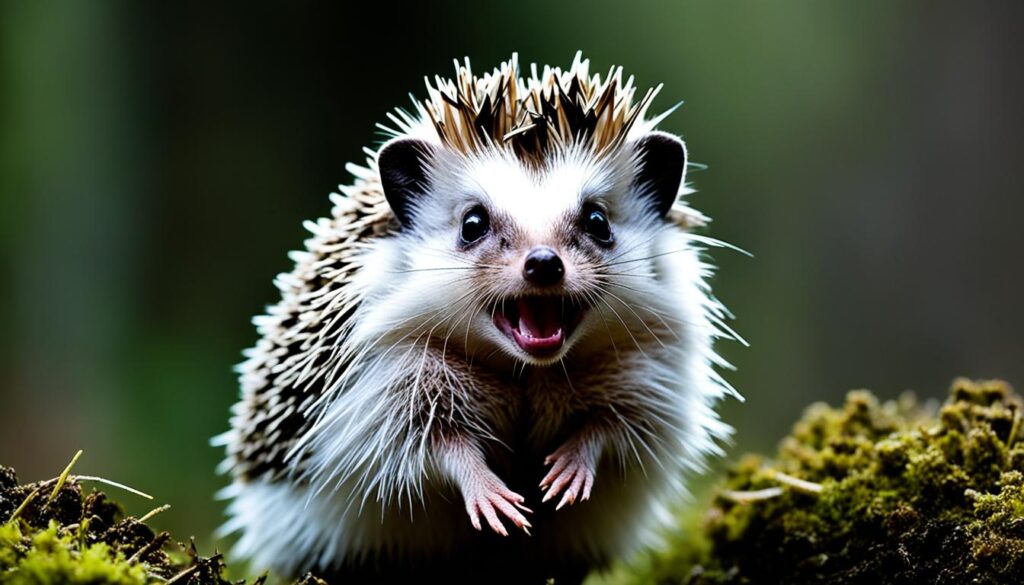
Noise Types
When it comes to vocalizations, hedgehogs have quite a repertoire. They can produce a variety of sounds, including:
- Chirping
- Whistling
- Purring
- Snorting
- Hissing
- Clicking
Emotional Indicators
Each vocalization can provide insight into your hedgehog’s emotional state. Chirping, whistling, and purring are often associated with contentment, indicating that your hedgehog is happy and comfortable. On the other hand, hissing and clicking typically signify fear or agitation.
Listening to your hedgehog’s vocalizations can help you gauge their mood and respond accordingly. If you hear a contented chirp or purr, you’ll know your hedgehog is feeling safe and satisfied.
Understanding and interpreting these hedgehog noises will enable you to provide appropriate care and create a comfortable environment for your spiky friend.
Anointing
One fascinating behavior exhibited by hedgehogs is anointing. When confronted with unfamiliar scents, hedgehogs produce foamy saliva and spread it on their quills. Although the exact purpose of anointing is not fully understood, it is believed to serve as a form of self-defense or a means of masking their scent from potential predators.
During anointing, hedgehogs create a foamy substance by vigorously agitating their saliva in their mouths. They then use their tongues to spread the foamy saliva onto their quills, ensuring that the scent of the unfamiliar object is incorporated into their own odor. This behavior is unique to hedgehogs and is a captivating display of their adaptive instincts.
Scientists speculate that anointing may have several benefits for hedgehogs. One theory suggests that by anointing themselves with the scent of a potential threat, hedgehogs can confuse predators or make themselves less recognizable as prey. Another hypothesis proposes that anointing allows hedgehogs to gather information about their environment by transferring scent molecules onto their quills and then sniffing and licking them, potentially helping them navigate their surroundings.
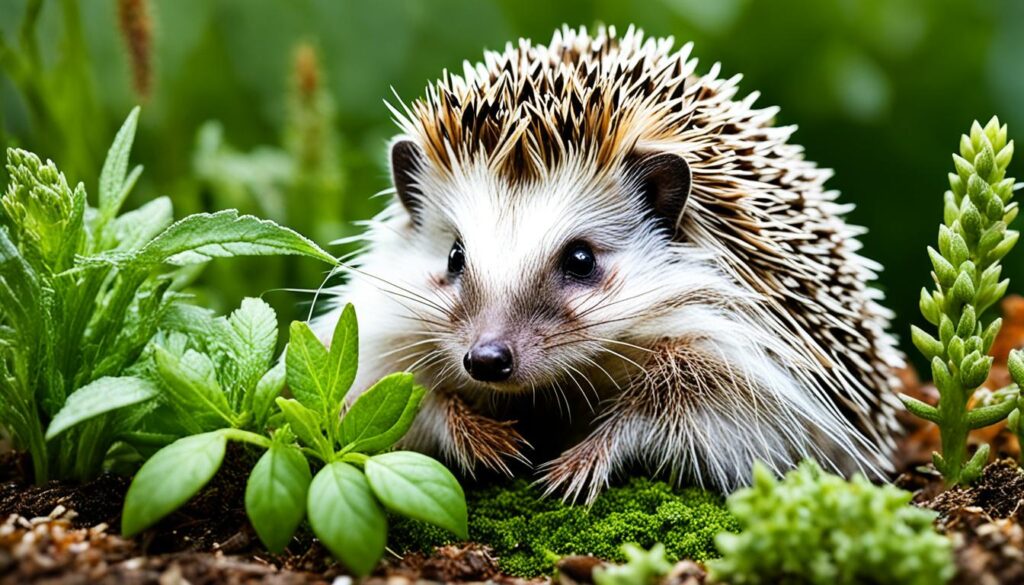
Further research is needed to fully comprehend the intricacies of this intriguing behavior and its precise purpose in the hedgehog’s natural repertoire. Nonetheless, anointing stands as a testament to the remarkable adaptability and unique qualities of these beloved spiky companions.
Physical Characteristics
When it comes to physical characteristics, hedgehogs have some fascinating features that make them unique among other small animals. Let’s take a closer look at their size, spines, and teeth.
Hedgehog Size
Hedgehogs are small creatures that typically weigh between 1/2 to 2 pounds. Their compact size makes them easy to handle and care for, while still providing a lovable companion for any hedgehog enthusiast.
Hedgehog Spines
One of the most distinctive features of hedgehogs is their spines. These spiky quills cover the hedgehog’s back and sides, making up around 35% of their total body weight. However, unlike porcupines, hedgehogs do not release their spines as a defense mechanism. Instead, they rely on their ability to curl into a tight ball and use their spines as a barrier of protection against predators.
Hedgehog Teeth
Hedgehogs have unique teeth that are quite different from those of other small mammals. With a long snout and a set of 36-44 teeth, hedgehogs use their dental structure to eat a diet that consists mainly of insects, small vertebrates, and plant matter. Unlike rodents, hedgehogs’ teeth do not continuously grow, which means they do not require constant chewing to keep them trimmed.
“Hedgehogs have some incredible physical traits that help them thrive in their natural habitat. From their quills to their teeth, each feature serves a specific purpose in their survival.”
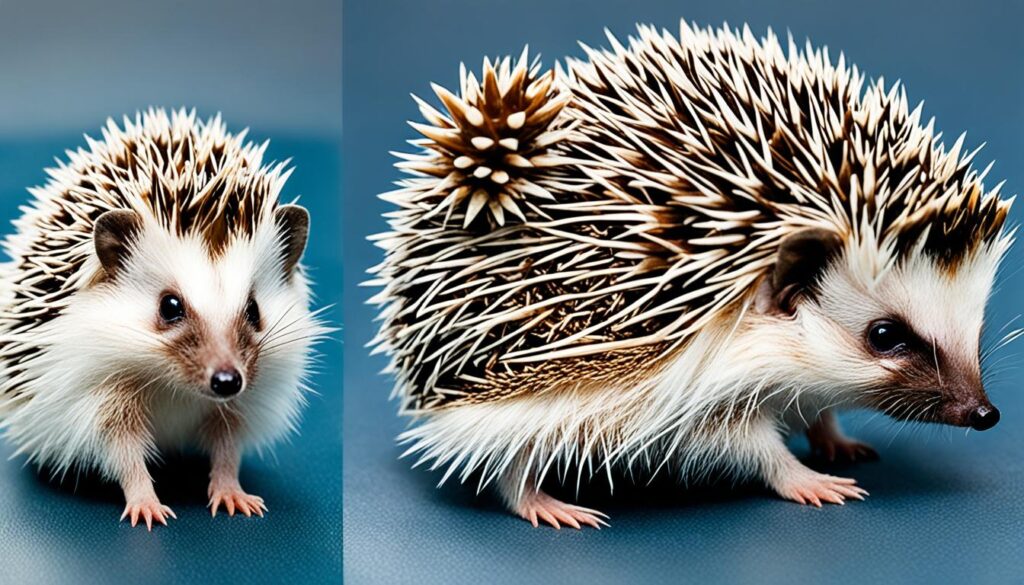
Having a better understanding of the physical characteristics of hedgehogs allows us to appreciate their uniqueness and provide them with the care they need. In the next section, we will explore hedgehog fur and coloration, which adds to their charm and individuality.
Fur and Coloration
When it comes to hedgehogs, their unique fur and coloration add to their charm and individuality. These small creatures have soft, white fur on their face and bellies, providing a contrast to their spiky exterior. But it’s their spines that really steal the show, with a wide range of color variations and markings.
Hedgehogs can have banded or solid-colored spines, and their coloration may change as they mature. This means that your hedgehog’s appearance can evolve over time, making them even more fascinating to observe and care for.
“Hedgehogs possess an incredible array of colors and patterns, with each unique combination resulting in a one-of-a-kind pet.”
There are over 90 recognized colors for pet hedgehogs, offering a wide selection for hedgehog enthusiasts. These colors vary not just in the quills, but also in the skin, face, nose, and leg coloration. This diversity allows you to find a hedgehog that perfectly matches your preferences and personal style.
Hedgehog Fur Colors and Patterns
Here are some examples of common hedgehog fur colors and patterns:
| Fur Color | Description |
|---|---|
| Albino | Completely white with red or pink eyes |
| Cinnamon | Brownish-reddish fur |
| Grey | Shades of gray fur |
| Salt and Pepper | Gray or silver fur with specks of black |
| Pinto | Irregular patches and spots of different colors |
| Reverse Pinto | Colored patches on a predominantly white background |
These are just a few examples, and there are many more beautiful and unique color variations in the hedgehog world. Whether you prefer a classic albino hedgehog or a funky pinto pattern, there’s a hedgehog out there to suit every taste.
So, if you’re considering getting a hedgehog as a pet, take some time to explore the fascinating world of hedgehog fur colors and patterns. You might just find the perfect hedgehog companion with a fur coat that matches their one-of-a-kind personality.

Senses
Hedgehogs have unique sensory abilities that help them navigate their environment and communicate with others. While their sight may be limited, they rely on their hearing and sense of smell to gather information about their surroundings.
Hedgehog’s Sight: Despite having eyes, hedgehogs have poor vision, particularly during the day. They primarily rely on their sense of smell and hearing to perceive their environment. However, hedgehogs can detect movement, allowing them to quickly sense potential danger.
Hedgehog’s Hearing: Hedgehogs have excellent hearing. They can pick up on a wide range of frequencies, which is important for detecting both prey and predators. Their acute hearing allows them to locate food sources and avoid potential threats.
Hedgehog’s Smell: Hedgehogs have a strong sense of smell, which plays a vital role in various aspects of their lives. They use their keen sense of smell to locate food, identify potential mates, and even detect danger in their surroundings. The aroma of food can quickly capture their attention and guide them to a tasty meal.
In general, hedgehogs rely less on their sense of sight and more on their hearing and smell to navigate their world. These senses help them survive in the wild and adapt to their surroundings.

Hedgehog’s Sensory Comparison:
| Senses | Sight | Hearing | Smell |
|---|---|---|---|
| Strength | Poor | Strong | Strong |
| Main Function | Sense movement | Detect prey and predators | Locate food, mates, and detect danger |
| Role in Survival | Minimal, compensated by other senses | Essential for locating food and avoiding danger | Crucial for finding sources of sustenance and recognizing threats |
As shown in the table above, hedgehogs have a weaker sense of sight compared to their hearing and smell. While their limited vision may seem like a disadvantage, they have evolved to rely heavily on their other senses to thrive in their natural habitat.
Sleep and Activity Patterns
Hedgehogs are fascinating creatures with unique sleep and activity patterns. As nocturnal animals, hedgehogs are naturally programmed to be active during the evening hours and sleep during the day.

Respecting their sleep is essential for their well-being, as disturbing their sleep can lead to agitation and stress. Providing a quiet and comfortable environment during their sleep time is crucial.
Hedgehogs typically sleep for around 18 hours a day, with their sleep duration varying based on factors such as age and individual preferences. During their active hours in the evening, hedgehogs engage in various behaviors, including exploring their surroundings, searching for food, and exercising on their exercise wheel.
Hedgehog Sleep Patterns and Behavior
Hedgehogs exhibit interesting sleep behaviors that reflect their natural instincts. When asleep, hedgehogs curl up into a tight ball, covering their vulnerable underside with their spiky quills for protection. This behavior not only helps them feel secure but also provides them with warmth.
It’s important to note that hedgehogs can sometimes exhibit interrupted sleep patterns, waking up briefly throughout their sleep cycle. These short awakenings are natural and serve as a survival mechanism for them to stay aware of their surroundings and potential threats.
Creating a Sleep-Friendly Environment
To ensure your hedgehog gets the proper rest it needs, it’s crucial to create a sleep-friendly environment:
- Provide a quiet and dimly lit space for your hedgehog to sleep undisturbed.
- Avoid loud noises and sudden disruptions that can startle or wake up your hedgehog.
- Ensure the temperature in their habitat remains consistent and within their comfort range.
- Offer a cozy nesting area with soft bedding material for them to burrow into.
Beyond creating a sleep-friendly environment, it’s important to establish a routine that aligns with your hedgehog’s natural sleep-wake cycle. This consistency helps hedgehogs feel secure and ensures they receive the rest they need to thrive.
| Sleep Environment | Sleep Tips |
|---|---|
| Quiet and dimly lit | Avoid bright lights or loud noises that can disrupt sleep. |
| Consistent temperature | Maintain a comfortable temperature range for your hedgehog. |
| Cozy nesting area | Provide soft bedding material for your hedgehog to burrow into. |
| Establish a routine | Follow a consistent schedule to help your hedgehog feel secure. |
By understanding and respecting the sleep and activity patterns of hedgehogs, you can ensure they lead healthy and content lives. Creating a sleep-friendly environment and providing ample opportunities for them to be active during their preferred hours will contribute to their overall well-being and happiness.
Unique Behaviors and Traits
Hedgehogs are fascinating pets with a variety of unique behaviors and traits that contribute to their individuality. Let’s explore some of these intriguing hedgehog habits and characteristics:
Digging
Hedgehogs are natural diggers and love to create tunnels and burrows. They use their sharp claws to dig into the ground, which serves multiple purposes. Digging helps them find food, hide from predators, and create a cozy nesting spot for themselves.
Rolling into a Ball
When hedgehogs feel threatened or scared, they have a remarkable defense mechanism – rolling into a tight ball. This behavior protects their vulnerable belly and exposes their spiky quills, deterring potential predators. It’s truly fascinating to see how they can transform from a cute little creature into a formidable-looking ball of spines.
Floating Effortlessly in Water
Contrary to popular belief, hedgehogs are proficient swimmers and can float effortlessly in water. They have the ability to paddle their tiny feet and navigate through water with surprising ease. While they may not purposefully seek out water for swimming, they may accidentally fall into shallow pools or ponds, and their natural swimming skills come into play.
Immunity to Some Snake Venom
Hedgehogs have a unique characteristic – they possess some level of immunity to snake venom. While this immunity is not absolute and depends on various factors, studies have shown that hedgehogs exhibit resistance to certain snake venoms. This fascinating adaptation helps them survive in their natural environment where encounters with snakes may occur.
These behaviors and traits make hedgehogs captivating pets, and getting to know their unique characteristics adds to the joy of having them as companions.

Conclusion
Understanding your hedgehog’s personality and unique traits is crucial for developing a strong bond with your spiky companion. By observing their body language and providing an environment that caters to their needs, you can create a safe and comfortable home for your hedgehog.
Building a relationship with your hedgehog takes time and patience. Pay attention to their quill behavior and vocalizations to understand their emotions and preferences. This will help you respond appropriately and ensure their well-being.
Remember, hedgehog bonding is a two-way street. Take the time to interact with your hedgehog regularly, providing mental stimulation and opportunities for play. Establishing trust and offering gentle handling will strengthen the bond between you and your hedgehog, allowing for a rewarding and fulfilling companionship.
